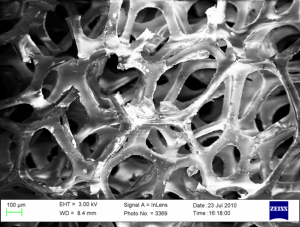Foam Filtration
Figure 1: Large filter experimental setup
Figure 2: Current implementation of the Small 4” Pipe Filter
Figure 3: Example of reticulated foam used in the foam filtration technology
| Excerpt |
|---|
Numerous techniques of water filtration are in use today, most of which involve the use of sand as the porous media. Foam filtration, however, goes beyond traditional water treatment methods and utilizes the filtering capacity of reticulated polyurethane foam. A foam filter requires less surface area, treats higher turbidity water (lab results have shown pC* values of 2 for 1000 NTU influent), wastes less water during backwash, and is less expensive to build than a traditional rapid sand filter. The primary goal of foam filtration is to design a low cost, locally sourced, easy to operate water filtration system for communities of less than 1,000 inhabitants and for disaster-relief scenarios where the community's main water supply has been compromised. |
Figure 1: Large filter experimental setup
Figure 2: Current implementation of the Small 4” Pipe Filter
Figure 3: Example of reticulated foam used in the foam filtration technology
Flow through the Filter: Turbid raw water is dosed with coagulant before moving through an inverted linear flow orifice meter and pouring into the top of the foam filter body. As the water passes through all the foam layers, large particles created during flocculation stick to the pores of the foam, removing them from the water and generating a clean, drinkable effluent. When the filter becomes clogged with large flocs, it must be cleaned by initiating the backwash cycle. The backwash system employs a wooden lever-arm to lift the foam and plunge it through water accumulated in the 55 gallon drum. This "plunge" creates a high velocity in the pores of the foam, shearing the captured particles off of the pore walls. The backwash water, which comes out the top of the foam layers, is then drained away, and the filtering cycle may resume.
...

